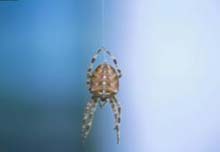Scientists Spin Spidery Silk

Image:©Sean O’Neill
Few things appear as delicate as a spider’s web, each gossamer strand one-tenth the width of a human hair. Yet pound for pound, the sturdiest spider silks are stronger than steel and stretchier than nylon. With such remarkable properties, it’s no wonder that researchers have made numerous attempts to synthesize spider silk for industrial and medical applications. (Efforts to farm the arachnids have failed as a result of their territorial nature.) Indeed, in the words of one scientist, this goal has long stood as the “Holy Grail of material science.”
To that end, findings published today in the journal Science represent a big step toward making that dream an ironclad reality. According to the report, a team led by investigators at the Canadian company Nexia Biotechnologies has coaxed mammalian cells into producing spinnable proteins by equipping them with spider silk genes. After harvesting the proteins, the scientists spun them from a water-based solution into fine, silken threads. The synthetic strands possess the strength and toughness—although not quite the tenacity—of spider-made dragline silks, the ones the creatures use in their web frames and safety lines.
Looking forward, Nexia hopes to produce large quantities of the recombinant spider silk, trade-named BioSteelR, using goats engineered to produce the spider silk proteins in their milk. If successful, future applications of harvested silk could include medical sutures, high-strength composites and soft body armor.
Media Contact
More Information:
http://www.sciam.com/news/011802/1.htmlAll latest news from the category: Materials Sciences
Materials management deals with the research, development, manufacturing and processing of raw and industrial materials. Key aspects here are biological and medical issues, which play an increasingly important role in this field.
innovations-report offers in-depth articles related to the development and application of materials and the structure and properties of new materials.
Newest articles
Faster, more energy-efficient way to manufacture an industrially important chemical
Zirconium combined with silicon nitride enhances the conversion of propane — present in natural gas — needed to create in-demand plastic, polypropylene. Polypropylene is a common type of plastic found…

Energy planning in Ghana as a role model for the world
Improving the resilience of energy systems in the Global South. What criteria should we use to better plan for resilient energy systems? How do socio-economic, technical and climate change related…

Artificial blood vessels could improve heart bypass outcomes
Artificial blood vessels could improve heart bypass outcomes. 3D-printed blood vessels, which closely mimic the properties of human veins, could transform the treatment of cardiovascular diseases. Strong, flexible, gel-like tubes…





















